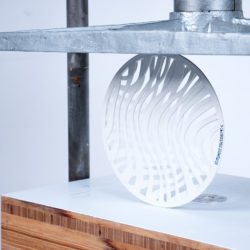M3: Machine – Mass – Mold
Description
„M3“ is a process project, in which I experiment with a self-built pressure-casting machine to create a new type of mold: the rotatable plaster mold. A pattern is cut into both parts of the form – the rotation of the halves creates infinite variations of the original pattern. The form spawns an – oxymoronically – industrial unicum.What is the Topic?
The mass product and the unicum embody two poles in the intersection of design, arts, and craftsmanship. What separates the “perfect“ duplicate of the “imperfect“ unicum? It is the constitutive process whose steps I am exploring. In my bachelor thesis I developed a pressure-casting machine that enables small series processes for an experimental design environment. For me, as a border crosser between design, art and craft, the control of the creative process is central: By being able to intervene in every step of the process, I determine whether craft, art or design is created.
Why does it look like this?
The entirety of the machine is the sum of its single parts: The compressor presses air pressure into a beer keg with porcelain slip. A hose is used to fill the plaster mould, whose two parts are held together by a book press. A pressure-constant filling of one to three minutes creates the product in the plaster mould: experimental porcelain plates with perforated structures. After various form tests, I decided to use two different designs - one irregular and one symmetrical: The "waves" are two different discs - one complements the other. When they lie exactly on top of each other, the pattern is completely closed. The "perforated disc", on the other hand, is completely symmetrical and repeats every quarter turn.
What is special?
The low-pressure casting machine opens up a completely new field of design: numerous restrictions that occur in the normal casting process with porcelain - such as the binding of the inner and outer shape or the lack of reinforcements for object stabilization - are solved with this process. Yet, pressure casting is normally only used for very high quantities and mature products. Tests are hardly possible. If possible, the come along with massive expenditure of time, cost and material – quite the opposite of experimenting. M3 takes up the small-series idea in low-pressure casting and adapts it to an experimental design environment. Only by controlling the creative process, new approaches can be developed!
What is new?
Moving from experimental approaches to using cases, I discovered that the rotatable mold is not only useful for decorating plates but also for, e.g., sieves with different sizes of meshes. Likewise, handles or spouts can be mounted in various positions without using different molds. This is particularly relevant when individualizing products, for example, for people with special needs. In times of cheap mass production and expensive case-by-case individualization, “M3” is a compromise between two worlds: porcelain industry and porcelain artisanship.




